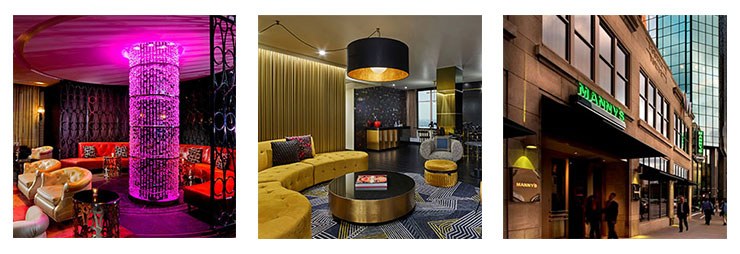A Historic Stay and Visit at The W Hotel & Foshay Tower
At 447 feet the Foshay Tower houses a luxury hotel with a storied past. Featuring a stylish design, a museum devoted to the tower's unique construction and its outlandish creator and a rooftop deck with a 360-degree view over Minneapolis, this is not your typical skyscraper.

Part Greek fable, part Citizen Kane - the story of Wilbur Foshay paints a picture of the rise and fall of a powerful tycoon in the twilight of the Roaring ‘20s. But the tale doesn’t end with the collapse of his utilities empire: The Foshay Tower became a beloved city landmark – locals love to tell stories of gangsters and rock stars seen in its legendary halls.
“It’s unique. Not everyone knows the whole story, even if they grew up here,” says Trina Anthony, Director of Sales and Marketing for the W Hotel. The stylish hospitality giant took over management of the 32-story Art Deco building after it was restored by Twin Cities real estate magnate Ralph Burnet in 2008.
Monumental History
A former art student fascinated by the design of the Washington Monument, Wilbur Foshay proposed building a similar tribute in Minneapolis to himself and his success, but as an office building that would dominate the Midwest skyline. So in 1927 he hired Leon Arnal for the job, a World War I hero and chief architect for Minneapolis firm Magney and Tusler.
Mathematical and monolithic, the skeleton of the building was made of reinforced steel and concrete. Continuous horizontal bands of windows allowed in patterned ribbons of light. Elaborately embellished doorways with cathedral style light fixtures, carved chevrons – and Foshay’s name carved in 10-foot-high letters on all four sides of the limestone pyramid embraced many of the features of progressive Art Deco design.
Although the base of the skyscraper was slated to be offices for the city’s top businesses, the 27th and 28th floors were just for Foshay himself. Arnal designed lavish private library and a three-bedroom, three-bath suite for the millionaire, with fireplaces, Italian and French marble walls, African Teakwood and Mahogany and glass paneled ceilings. The bathrooms featured gold fixtures.
It took two years to build, three days and $125 thousand to celebrate the Foshay Tower’s Grand Opening on Labor Day weekend of 1929. Just weeks after the opening celebration, the stock market crashed and Foshay couldn’t pay the builders. The payroll bounced. His Ponzi scheme backfired. He had advertised and sold overvalued stock using the federal postal service. Penniless, Foshay was tried on criminal mail fraud charges and sent to Leavenworth prison. His company folded, and the tower went up for sale.
Foshay never got a chance to use his Shangri-La; unable to pay the people who built his dream, they never completed the bedroom suite on the 28th floor. The stairs in the library metaphorically became a staircase to nowhere – an epitaph on Wilbur Foshay’s quest to own the ‘Best Address in the Midwest.'
A New Era: The Glamour is Back

The Foshay changed business owners several times throughout the years. A number of today’s major corporations were also tenants at the Foshay: Colgate toothpaste was just one of the products the Palmolive Peet Company made while renting space on the 11th floor. C & H Sugar was right down the hall. Campbell Cereal was just one floor above – the Minnesota food maker was known across the country for its one product – Malt O Meal. The “Smooth and Creamy” breakfast cereal was sold in 70% of US supermarkets. And giant General Motors kept executive suites for its executives selling Oldsmobile, Pontiacs and Buicks in the Twin Cities.
In the late 1970s, while other downtown buildings of the era were being raised, the Heritage Preservation Commission had the Foshay designated a local landmark by the National Register of Historic Places. They knew the building’s gilded age and significant design would not only appeal to certain businesses who loved its character. It also protected the 162,000 sq. foot Art Deco building from ever being altered or destroyed.
Real estate giant Ralph Burnet bought the Foshay in 2006 for $16 million dollars, then pumped five times that amount into plans to give the Foshay a new, exciting chapter. A flamboyant businessman and internationally known art collector, Burnet and his group of investors made the decision to turn the landmark into one of the hottest hotels in the city.
The Living Room: Hotel Lobby Bar
In the lobby, interior designers were brought in to blend the old with the new: Italian neon bathes the Foshay’s dramatic 1930s hallway in a warm pink glow. High back leather smoking chairs and 10-foot palms overlook the shower of cascading blue glass beads in the hotel’s posh oval lounge area, known as The Living Room. This is where Prince’s favorite DJ, Lenka Paris, can sometimes be heard commanding the beat while locals and visitors mingle at the pure white marble top bar with artisan cocktails.
Manny’s Steakhouse
It all leads to a five-panel green door with a heavy brass steer knocker – Manny’s Steakhouse, one of the greatest steakhouses in the world. A Twin Cities’ dining institution, guests are warned not to fill up before making reservations: Manny’s steaks are a James Beard award-winning experience: The “small” filet mignon (8 oz.) with loaded mashed potatoes are signature dishes. Leave room for dessert – Manny’s Death by Chocolate is a delicious way to go, piled high with dark chocolate, mousse, whipped cream and chocolate sauce.
Prohibition Bar
Late night drinks in comfort are waiting on the 27th and 28th floors in Wilbur Foshay’s study. Known as the Prohibition Bar, Foshay’s elaborate library is an intimate space still featuring its original wood panel bookshelves, fireplace and curved office doors. Leather ottomans and arced modern floor lamps surround lacquered black cocktail tables that boast beautiful views of the city. The stairwells lead to nowhere – designed to connect to Foshay’s unfinished living quarters and four premier suites.
Keys at the Foshay
The Art Deco interior spills over to another food experience within the the building. Located on the ground floor, Keys at the Foshay brings the family-friendly atmosphere. It is considered a breakfast favorite with it's hearty and home-style meals.
Hotel Rooms
Overnight at the Foshay offers a romantic, sophisticated stay. Each of the 230 rooms are a collage of Art Deco Suites with modern twists. Guests are invited to linger in their plush pillow top bed in one of the hotel’s spectacular suites like the “Extreme Wow”, featuring a stylish living room, dining area and bar and all of downtown outside their six-foot picture windows.
Visiting The Foshay Museum & Observation Deck

Respectful stewards of the tower’s legacy, a museum honoring its visionary sits atop of the 447-foot wonder.
But the trip into the building’s past starts in the arcade lobby, resplendent with bronze wrought iron grillwork and rose-colored Italian marble walls. Tiered glass chandeliers hang from recessed light fixtures. Gilded moldings wrap each corner of the high white ceilings.
The brass and terrazzo geometric walkway leads to an elevator with signature doors featuring swirling metal latticework of the 1920s skyscraper. Visitors are whisked from the lobby up 30 stories to the 1,500 sq. ft exhibition room where more than 100 artifacts reveal Foshay’s spare-no-expense attitude towards his paragon of excellence: elaborate gold plumbing and lighting fixtures, ornate clocks. A collection of brass office keys. Construction pictures. Foshay’s silk top hat and pictures from the Opening Celebration. Postcards featuring the historic landmark. Preliminary sketches made of the Foshay by Leon Arnal. Even the sheet music from Sousa’s Foshay March is on display. Visitors can touch the digital displays to see the Foshay’s past come to life with vintage photos, stories of Wilbur Foshay and fascinating details on the transformation of the landmark tower into a contemporary hotel.
A staircase leads out from the museum to the Observation Deck for an open-air, 360-degree view of Minneapolis. Telescopes give a breathtaking view of the city’s lakes and neighborhoods, as well as the new skyscrapers that now tower the once-towering Foshay. More than 6,000 people visit the museum every year, five days a week according to Anthony. It’s a $10 dollar trip (complimentary to hotel guests) down memory lane for some, she says. Others get a look at how much the city has changed through the years. But she says it’s really an opportunity to understand why The Foshay is such an important part of the city’s collective identity. “After all these years, there’s a connectiveness of the tower to the community,” says Anthony. “It’s its own architectural wonder.” The Museum and observation deck are open Thursday-Monday, 11am-5pm. (Observation Deck Winter hours are subject to the weather. Please call ahead).
Also note The Observation Deck can only be reached by climbing two flights of stairs.
In the Heart of It All
The Foshay Tower adds character and luxury to the Minneapolis skyline. It stands in the middle of downtown Minneapolis which puts it just a few blocks away from the METRO Light Rail line and in close proximity to many Minneapolis attractions. If you stay at this extravagant hotel you'll be close to plenty of action whether it's a theatre shows, sporting events or live music and concerts. Or if you're nearby stop in to learn about the city's history and see downtown from a whole new perspective.

